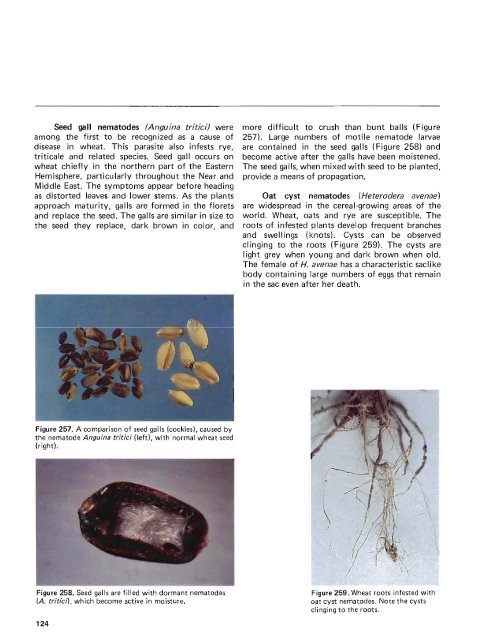Distinguishing the species - CIMMYT
Distinguishing the species - CIMMYT
Distinguishing the species - CIMMYT
You also want an ePaper? Increase the reach of your titles
YUMPU automatically turns print PDFs into web optimized ePapers that Google loves.
Seed gall nematodes (Anguina tritici) were<br />
among <strong>the</strong> first to be recognized as a cause of<br />
disease in wheat. This parasite also infests rye,<br />
triticale and related <strong>species</strong>. Seed gall occurs on<br />
wheat chiefly in <strong>the</strong> nor<strong>the</strong>rn part of <strong>the</strong> Eastern<br />
Hemisphere, particularly throughout <strong>the</strong> Near and<br />
Middle East. The symptoms appear before heading<br />
as distorted leaves and lower stems. As <strong>the</strong> plants<br />
approach matu rity, ga lis are formed in <strong>the</strong> florets<br />
and replace <strong>the</strong> seed. The galls are similar in size to<br />
<strong>the</strong> seed <strong>the</strong>y replace, dark brown in color, and<br />
Figure 257. A comparison of seed galls (cockles), caused by<br />
<strong>the</strong> nematode Anguina tritici (left)' with normal wheat seed<br />
(right).<br />
Figure 258. Seed galls are filled with dormant nematodes<br />
(A. tritie;), which become active in moisture.<br />
124<br />
more difficult to crush than bunt balls (Figure<br />
257). Large numbers of motile nematode larvae<br />
are contained in <strong>the</strong> seed galls (Figure 258) and<br />
become active after <strong>the</strong> galls have been moistened.<br />
The seed galls, when mixed with seed to be planted,<br />
provide a means of propagation.<br />
Oat cyst nematodes (Heterodera avenae)<br />
are widespread in <strong>the</strong> cereal-growing areas of <strong>the</strong><br />
world. Wheat, oats and rye are susceptible. The<br />
roots of infested plants develop frequent branches<br />
and swellings (knots). Cysts can be observed<br />
clinging to <strong>the</strong> roots (Figure 259). The cysts are<br />
light grey when young and dark brown when old.<br />
The female of H. avenae has a characteristic saclike<br />
body containing large numbers of eggs that remain<br />
in <strong>the</strong> sac even after her death.<br />
\<br />
Figure 259. Wheat roots infested with<br />
oat cyst nematodes. Note <strong>the</strong> cysts<br />
clinging to <strong>the</strong> roots.

















